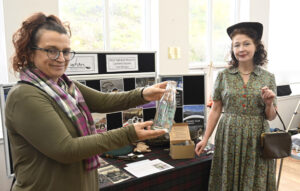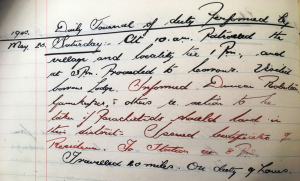
Trainee archivist Rory Green continues his journey through the fascinating collections at the Lochaber Archive Centre.

On Wednesday September 27 the Lochaber Archive Service and the West Highland Museum joined forces to deliver Their Finest Hour, a University of Oxford-designed project that collects and digitally archives stories and objects relating to the Second World War.
The project, funded by the National Lottery Heritage Fund, initially launched in July 2022 and aims to empower local communities in preserving stories and objects connected to the Second World War before they are lost to posterity.
Gathering sessions for the project are being held in communities across the UK this year, and the Lochaber Archive Centre was delighted to support the West Highland Museum in hosting a session at the Duncansburgh Church Hall in Fort William.
The day was a success and all those involved in organising it are extremely grateful to everybody who came along with stories and objects, and to everyone who popped in for a cup of tea, a chat, and a look round at the fantastic display stalls.
In this article, I want to share with you some items from our own collections which help to tell the story of Lochaber during the Second World War.

First is an excerpt from the Burgh of Fort William Town Council Minute Book, dated October 7, 1940, which lists the location of public air raid shelters in Fort William and how many people they could hold.
The Ben Nevis Buildings and the basement of the Masonic Hall certainly had the largest capacities, both able to hold 140 people. The smallest capacity was the Wash House on the High Street, holding only 25.

Secondly, an entry in the Spean Bridge Police Station Daily Occurrence Book, dated May 26, 1940, regarding the possibility of parachutists landing in the area, reads ‘Informed Duncan Robertson, Gamekeeper, and others the action to be taken if parachutists should land in this district. Issued Certificates of Residence.’

And finally, an entry in Lochailort School Log Book, regarding the admittance of
10 evacuees, who were accommodated at the Lochailort Hotel, dated April 22, 1941.
These are but a few examples of the types of records one can consult in order to better understand life in various periods of history. They are able to be viewed in our archive search room on a Tuesday, Thursday, and Friday, 10am-4.30pm.
• On Wednesday October 18 the Lochaber Archive Centre will launch Archive Afternoons.
Running every third Wednesday from 2.30pm to 4.30pm, these free sessions will give members of the public the opportunity to explore the past, learn something new, and reminisce with friends, with no need to book.
For the first event, Ken Johnston, will present his talk about the history of the Charles Kennedy Building.
This will take place at the Lochaber Archive Centre, alongside a specially curated exhibition which will be on display in the Searchroom.
The exhibition will showcase our collections and will be on the theme of Buildings and Built Heritage.
www.highlifehighland.com/archives-service/
www.facebook.com/LochaberArchiveCentre
www.instagram.com/hlharchives/
email: lochaber.archives@highlifehighland.com